Thai food is world-famous for its balance of spicy, salty, sweet, and sour—but the real magic is in the Thai sauce. Whether you’re stirring together a quick dipping sauce or crafting a deeply flavored curry base, Thai sauces are essential to the country’s culinary identity. In this guide, you’ll learn what goes into them, how they’re used, and why they make even the simplest meals unforgettable. We’ll cover essential ingredients, classic recipes, and tips you can actually use in your home kitchen. If you’ve ever wondered what sets Thai food apart, spoiler alert—it’s the sauce.
Print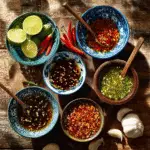
Sauce Thai: The Ultimate Guide to Thailand’s Bold & Flavorful Condiments
- Total Time: 5 minutes
- Yield: 1/3 cup
Description
A simple and balanced sauce Thai that works as a dip, dressing, or marinade.
Ingredients
2 tbsp fish sauce
1 tbsp lime juice
1 tsp sugar (palm or brown)
1 clove garlic, minced
1 small Thai chili, finely chopped
Instructions
1. In a small bowl, combine fish sauce and lime juice.
2. Add sugar and stir until dissolved.
3. Stir in garlic and chopped chili.
4. Taste and adjust sweetness or spice if needed.
5. Serve immediately or store refrigerated for up to 3 days.
Notes
You can swap Thai chili for red pepper flakes for milder heat.
Try this sauce with grilled meats, rice bowls, or even over roasted veggies.
- Prep Time: 5 minutes
- Cook Time: 0 minutes
- Category: Sauce
- Method: No-Cook
- Cuisine: Thai
Table of Contents
The Heart of Thai Cooking Lies in the Sauce
A Sweet & Spicy Memory in My Kitchen
It started with a splatter of chili paste on my ceiling. I had found a recipe for homemade pad Thai and—like many of us do—decided to eyeball the ingredients. The moment garlic and fish sauce hit the hot oil, the smell alone brought my husband into the kitchen asking, “What is that, and can I eat it now?” That’s when I knew I was cooking with something special.
I didn’t grow up with Thai sauce, but once I discovered it, I couldn’t stop experimenting. That first pad Thai sauce had tamarind, palm sugar, fish sauce, and lime juice. It was sweet, salty, sour, and tangy—all in one. I’ve since made dozens of variations, each one teaching me more about how these flavors work together. When I say sauce Thai changed my kitchen, I mean it literally changed how I think about flavor.
One night, while testing a peanut-lime dipping sauce, I ended up drizzling it on leftover roasted sweet potatoes. That combo? Ridiculously good. Thai sauces are like that—they bring life to anything they touch. Even a basic meal becomes bold with a splash of the right sauce.
For more recipes :
Thai Sauce Basics
Common Ingredients That Build Thai Sauce Flavor
If you’ve ever tasted a Thai dish and thought, “How does this taste so good?”—chances are, the answer lies in the Thai sauce. At the core of every great Thai sauce are a few key players that create a harmony of flavors. Thai food is all about balance, and the sauces reflect that beautifully.
Most Thai sauces start with fish sauce—salty, funky, and full of umami. It’s the backbone of countless dishes. Then there’s lime juice, which adds brightness and cuts through the richness. Palm sugar (or brown sugar if that’s what you’ve got) brings the sweetness, while Thai chilies crank up the heat in that unmistakable way—garlic, shallots, and tamarind paste round things out with depth and tang.
What sets sauce Thai apart from other sauces is how it combines these simple ingredients to hit every taste bud at once. One spoonful might be sweet, the next sour, and by the third, you’re hooked. No one element dominates; they work together to create something unforgettable.
Staples in Every Thai Pantry
If you want to make Thai sauce at home, there are a few staples worth keeping on hand. Start with fish sauce—it’s non-negotiable. Then grab oyster sauce (for stir-fries), soy sauce (preferably Thai-style, which is lighter than Chinese), and rice vinegar. Don’t forget chili garlic paste, sweet chili sauce, and tamarind concentrate.
These ingredients show up in everything from noodle sauces to grilled meat marinades. For example, that crave-worthy dipping sauce served with spring rolls? Usually, sweet chili sauce with a touch of vinegar. A spicy grilled chicken marinade? Likely a mix of oyster sauce, fish sauce, and chilies.
If you’re diving into curry pastes, those are sauces in their own right—concentrated blends of herbs and aromatics. You can make them from scratch or buy premade versions that are surprisingly good with a little tweaking. Either way, they’re the base of many authentic Thai dishes.
Core ingredients used in traditional Thai sauces
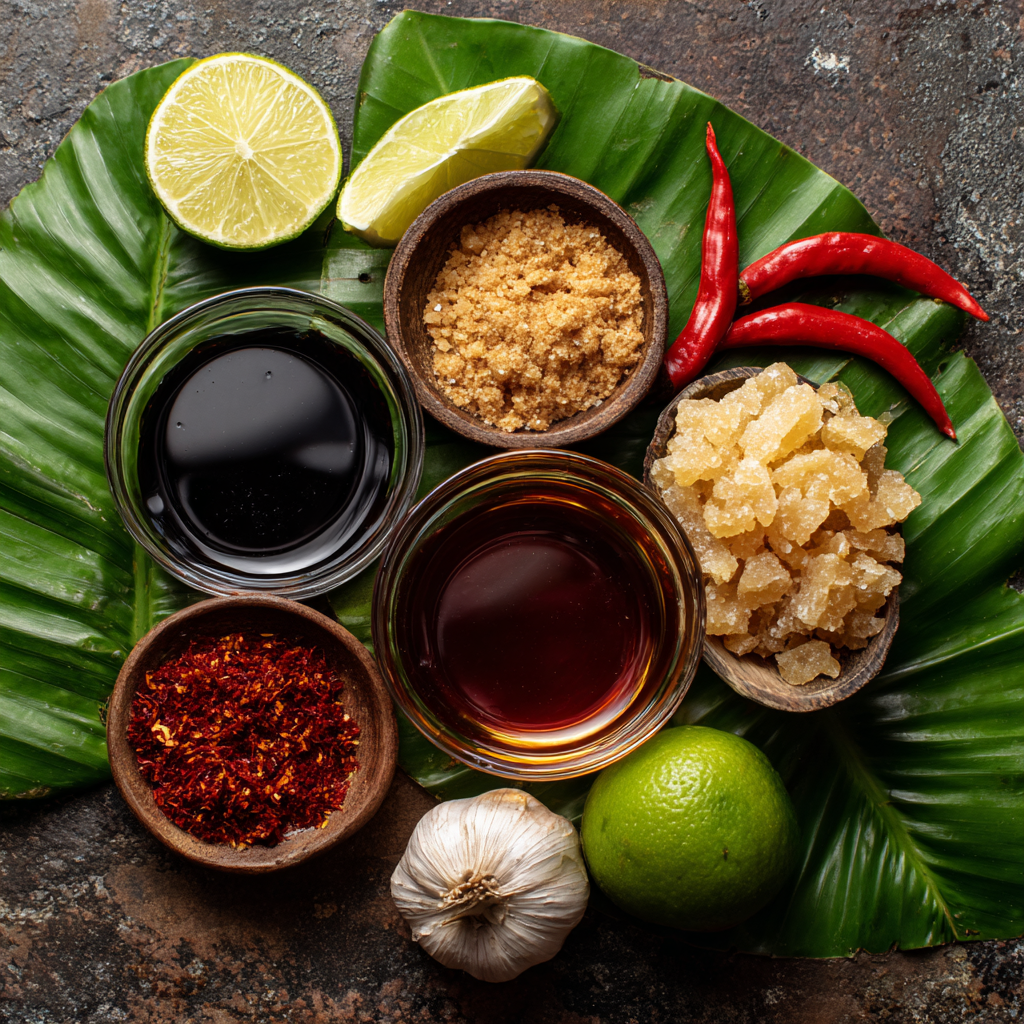
Types and Variations
Popular Thai Sauces You Need to Know
Now that we’ve covered the ingredients, let’s talk about the actual stars—those flavorful creations that define Thai meals. There isn’t just one Thai sauce; there are dozens, each with its own bold character and purpose.
Let’s start with Nam Pla Prik, the go-to Thai table condiment. It’s made of fish sauce, lime juice, chilies, and garlic. Spicy, salty, sour—this sauce goes on everything from fried rice to grilled meats.
Then there’s Nam Jim Jaew, a smoky dipping sauce from northeastern Thailand. It’s spicy and tangy with toasted rice powder that adds a nutty crunch. It’s perfect for grilled beef or pork, and a little goes a long way.
Nam Prik Pao is a Thai chili jam. It’s sweet, smoky, and spicy, usually made with roasted chilies, shallots, garlic, and shrimp paste. Stir it into soup or spread it on toast—it’s wildly versatile.
Of course, no talk of Thai sauce would be complete without Satay Peanut Sauce. Creamy and nutty, with a kick of red curry and sweetness from coconut milk and sugar, it pairs beautifully with skewers, tofu, or even roasted vegetables.
Pad Thai Sauce deserves a spotlight of its own. Made from tamarind, palm sugar, and fish sauce, it’s what gives that iconic noodle dish its bold, slightly sweet flavor.
From Street Carts to Home Kitchens: When & How They’re Used
In Thailand, sauces aren’t an afterthought. They’re planned and prepared with care, often in advance, then served fresh alongside the meal. Street vendors will mix sauces right in front of you, tailoring the flavors based on the dish—or even your spice tolerance.
Nam Jim Seafood is often paired with grilled shrimp or squid. Meanwhile, you’ll find Thai sweet chili sauce at nearly every fried snack stall. And if you’ve ever dipped chicken into that reddish-orange sauce and thought, “I need this bottled,” you’re not alone.
One of my favorite twists was using my leftover peanut sauce in a wrap with grilled tofu and crunchy cabbage. Another time, I drizzled Thai sauce over warm quinoa from my autoimmune paleo meals plan—don’t knock it till you try it.
A Thai vendor is preparing sauce fresh at a street stall.
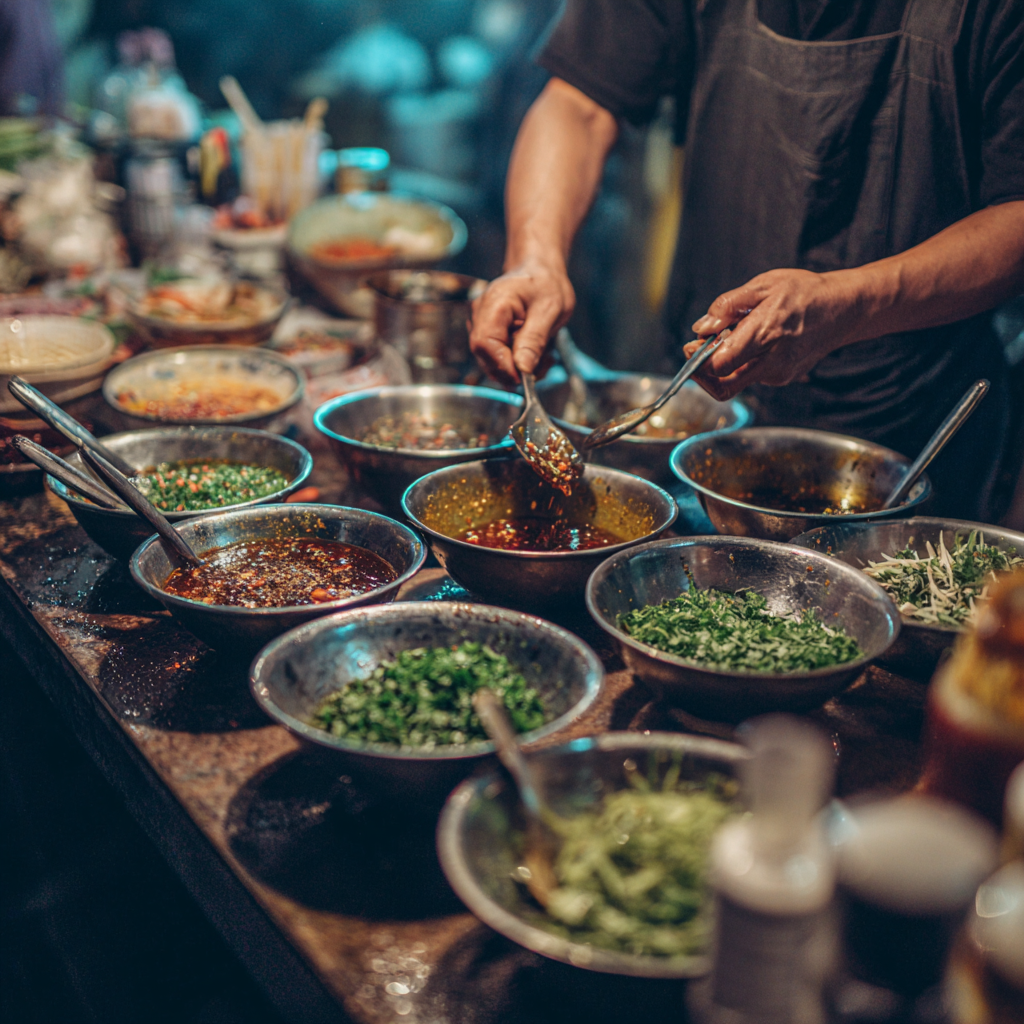
The Flavors of Thailand
The Balance: Sweet, Sour, Salty, Spicy, Bitter
If you’ve ever tasted something in Thai food that felt like it hit every flavor note at once—congrats, you’ve met the five Thai pillars. In Thai cuisine, balance isn’t a buzzword. It’s a must. And the place where that balance shines brightest is in the sauce Thai.
Let’s break them down.
Sweet often comes from palm sugar, brown sugar, or even sweet chili sauce. It softens the spice and brings richness to dipping sauces or curry pastes.
Sour is typically introduced through lime juice, tamarind, or vinegar. It brightens dishes like papaya salad or Thai-style dressings.
Salty is the anchor. Fish sauce, soy sauce, and shrimp paste provide umami and deepen the overall flavor. Even a tiny amount can change the entire dish.
Spicy is what Thai food is known for. Chilies, both fresh and dried, are added depending on the heat level you want. From mild to mouth-melting, spice is always in play.
Bitter, though subtle, often comes from certain herbs like Thai basil or bitter melon in soups. It grounds the brighter notes and adds depth.
A great Thai sauce combines at least three of these five. Pad Thai sauce? Sweet, sour, salty. Nam jim jaew? Salty, sour, spicy. Even a basic fish sauce dip with lime and garlic hits every corner of your palate.
How Sauce Ties It All Together
Think of sauce as the translator between ingredients. It doesn’t just add flavor—it connects them. A bowl of plain rice or grilled chicken becomes something crave-worthy when paired with the right Thai sauce.
I’ve seen this happen with the simplest meals. I once had steamed vegetables and tossed them with a quick dressing of soy sauce, lime, and chili flakes. It was one of the most flavor-packed lunches I’ve made—and it took less than 10 minutes.
Even comfort dishes like rice porridge benefit from a splash of something savory and spicy. That’s where sauce Thai works its magic—it adds heart and heat in a single spoonful.
Sauce Thai paired with grilled skewers and sticky rice.
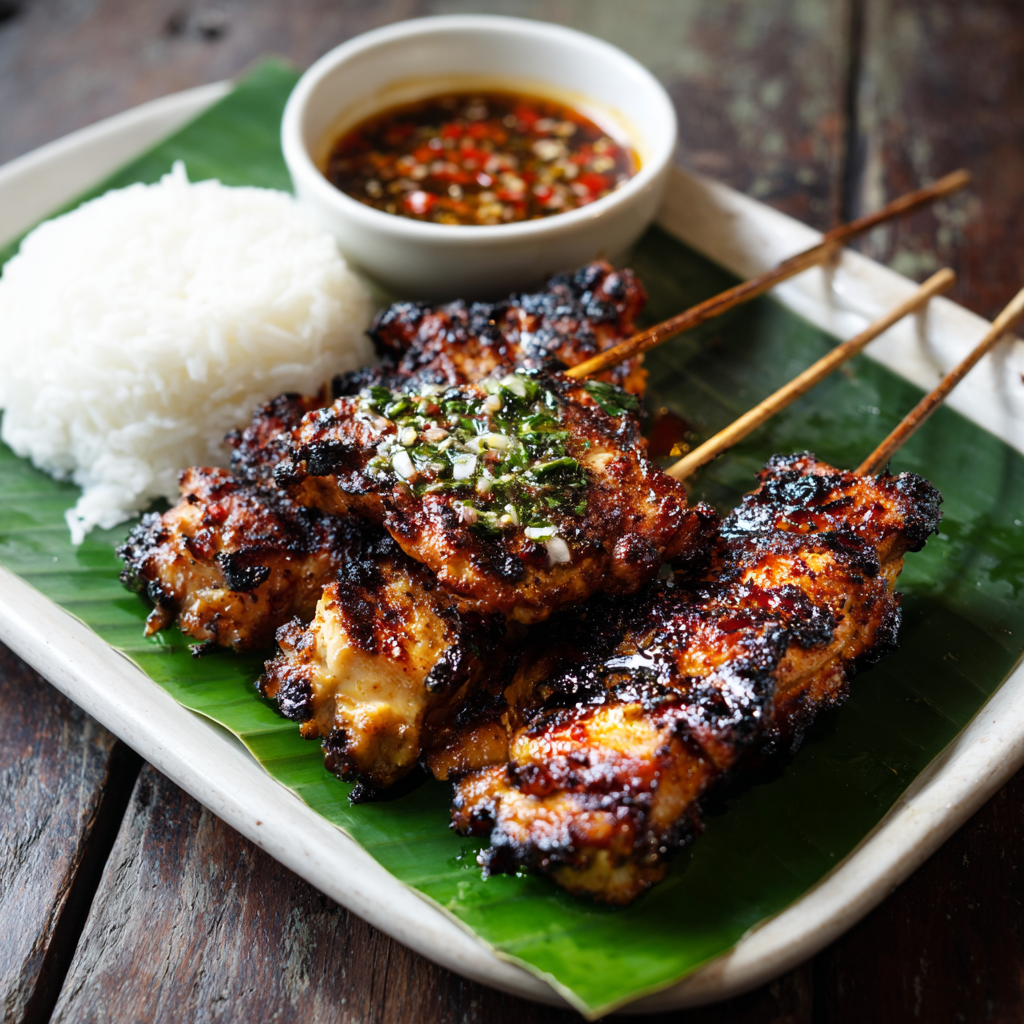
FAQ
What is Thai sauce made of?
Thai sauces are typically made with a few key ingredients that balance salty, sweet, sour, and spicy. Common components include fish sauce, lime juice, chilies, garlic, tamarind paste, palm sugar, and soy sauce. Some versions also include coconut milk, ginger, or shrimp paste depending on the dish.
What is Thai sauce called?
There isn’t just one name for Thai sauce—it depends on the type. You’ll hear names like Nam Pla Prik (fish sauce with chilies and lime), Nam Jim Jaew (grilled meat dipping sauce), and Nam Prik Pao (chili jam). Each one is a unique sauce Thai used in different dishes and settings.
What Thai sauces are there?
Some of the most popular Thai sauces include:
Nam Jim Jaew (grilled meat dipping sauce)
Nam Prik Pao (chili jam)
Nam Pla Prik (table condiment)
Satay Peanut Sauce
Pad Thai Sauce
Sweet Chili Sauce
These sauces can be used for dipping, dressing, or cooking depending on the meal.
What are the 5 Thai flavors?
The five core flavors in Thai cuisine are sweet, sour, salty, spicy, and bitter. Thai sauces are known for balancing at least three of these in every recipe. For example, a simple dipping sauce Thai might combine lime juice (sour), fish sauce (salty), and sugar (sweet), with chilies added for spice.
Conclusion
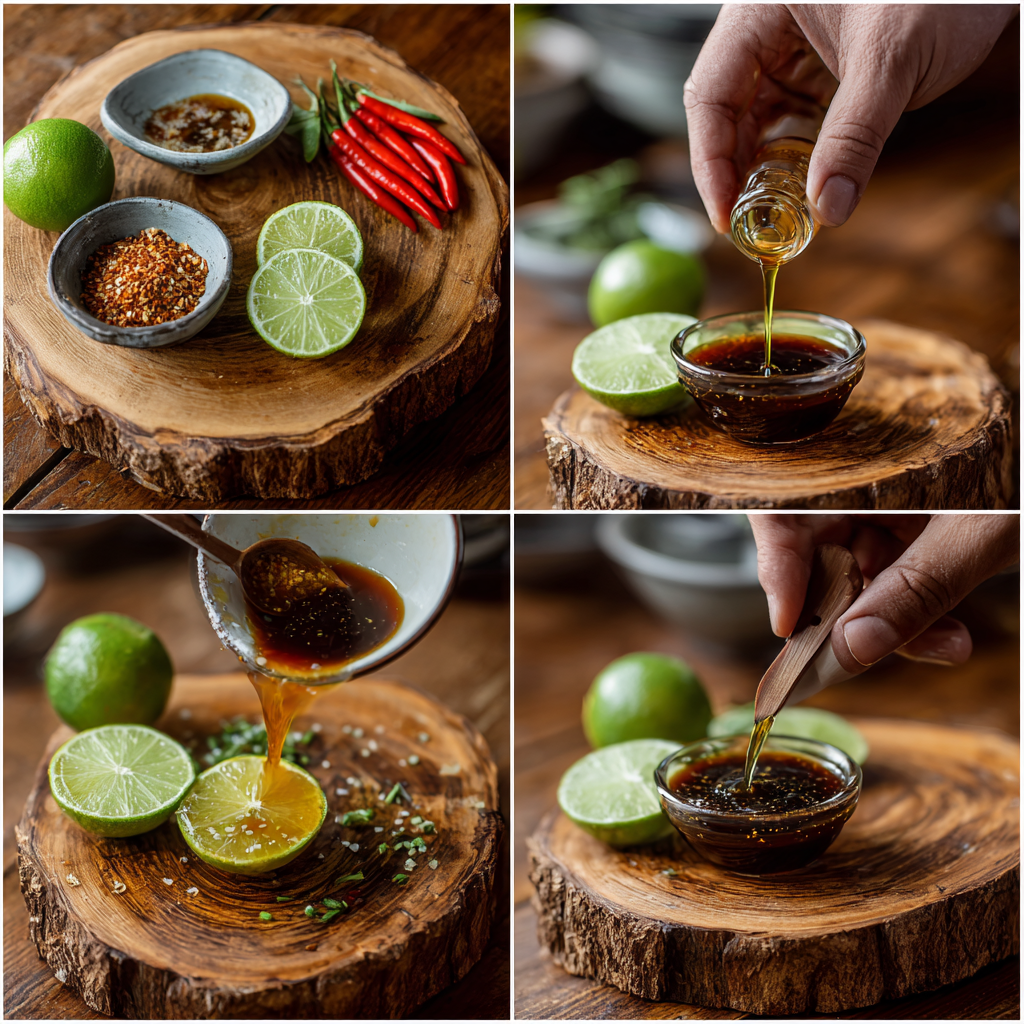
There’s nothing “extra” about sauce in Thai cooking—it’s essential. Whether you’re whipping up a quick noodle dish, marinating grilled chicken, or just dipping fresh veggies, the right sauce Thai transforms your food from basic to bold. It’s not about copying a restaurant dish—it’s about creating flavor that feels alive in your kitchen.

